You are using an out of date browser. It may not display this or other websites correctly.
You should upgrade or use an alternative browser.
You should upgrade or use an alternative browser.
The Chronicles of Khan
- Thread starter Sandman2003
- Start date
Sandman2003
Prince
In spite of what I said earlier in this thread, I am actually seriously considering such an attempt next, Ignas.ignas said:Interesting game waiting for your Sid attempt
rbis4rbb, the update is coming. It has been played, just needs tp be written up!
Tman65
Warlord

Waiting patiently....well maybe not so patiently for the Great Kahn

Sandman2003
Prince
Chapter Twenty Two – Destiny
Amazing throughout the short but brutal war on the Babylonians, the Incans kept very quiet. The right of passage treaty between the Mongols and the Incans was still in force which was quite incredible given the way that the Mongols had abused the terms of these agreements in the past. The reason for the Incan indifference was to become known to the Mongols when they successfully planted a spy into the Incan heartland in 1460AD.
The Incan military was almost 1.2 million troops! Included in this force was 70 divisions of the powerful rifle divisions and 47 divisions of the still highly effective cavalry divisions. Clearly with any offensive aimed at the Incans, the Incans would be able to bite back, and given the paranoia of the free populace under the democratic government, this could certainly hurt the war effort. Troop numbers were actually closer to 1.4 million, but this included numerous now outdated divisions.
With 30 cities as well, the Incans were significantly larger than the previous foes, and certainly would not crumble nearly as easily to the Mongols offensive. Still the Mongols now had a regular stream of tanks, and infantry, not to mention over twenty of the highly effective army units. Delay would just delay the ultimate declaration of peace through the Pax Mongolia, so once again, troops were positioned for maximum effectiveness utilising the right of passage agreement.
During this time, there were few Incans who were concerned about the movement of Mongolian troops through their lands. After all, this had been going on for a long time now! Those that raised concerns were quickly rebuffed, and reminded of the friendship between the two nations, and the strong army of the Incans. Also, Inca still has no natural railroads of its own. So communications were slow via the road networks in place. This enabled the Mongols to launch their first attacks with almost complete surprise.
The Incan territory was composed of four large territories surrounding the former Babylonia, and with two solitary isolated cities, one in the far east, and one close to South East Inca. This meant a huge logistical problem as far as securing the enormous shared border with the foe, so it was important that the war be over with quickly!
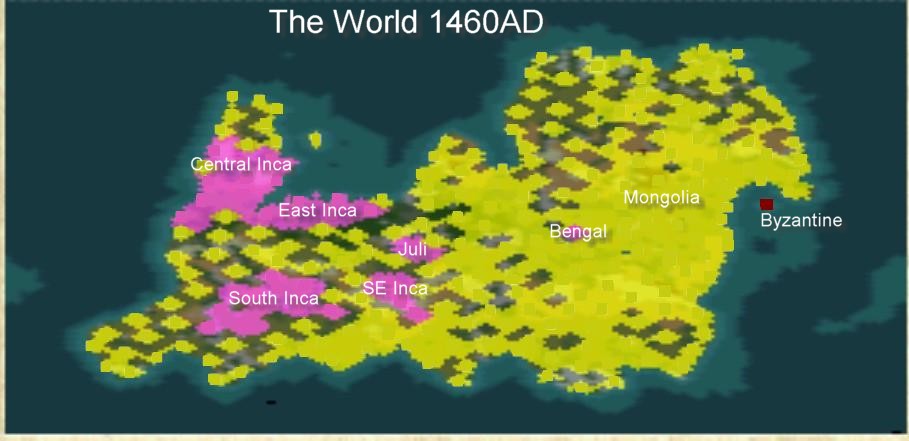
Some in the Khan’s war cabinet advised a rest between the Babylonian campaign and the Incan campaign, pointing to the need for the soldiers to rest, and the fact that more tank divisions were rapidly coming on line, enabling an ever more overwhelming attack to occur. The Khan would have none of this. With the potential for true lasting peace so close to his grasp, the troops were ordered into their respective positions without delay. The action was to commence in Central Inca – the heartland of the enemy itself!
Central Inca
Tiwanaku received the first shots of the campaign. Tiwanaku was the key to the northern cities with the Mongolian rail infrastructure already built around the city during the Dutch War. Artllery struck the city first, fired from afar. Even the mighty Incans had no answer to this onslaught, leaving the three rifle divisions easy prey to the third keshik army.
Huamanga was the Incan city farthest to the North, and annoyingly added substantially to the northern front with the enemy. This was due to how the Dutch had colonised just to the city’s south. That city, Eindhoven, now of course belonging to the Mongols. Therefore it was crucial that it fell quickly so as to secure the north-west peninsular. It only took the first cavalry army to crush the three rifle divisions defending there, and remove this threat.
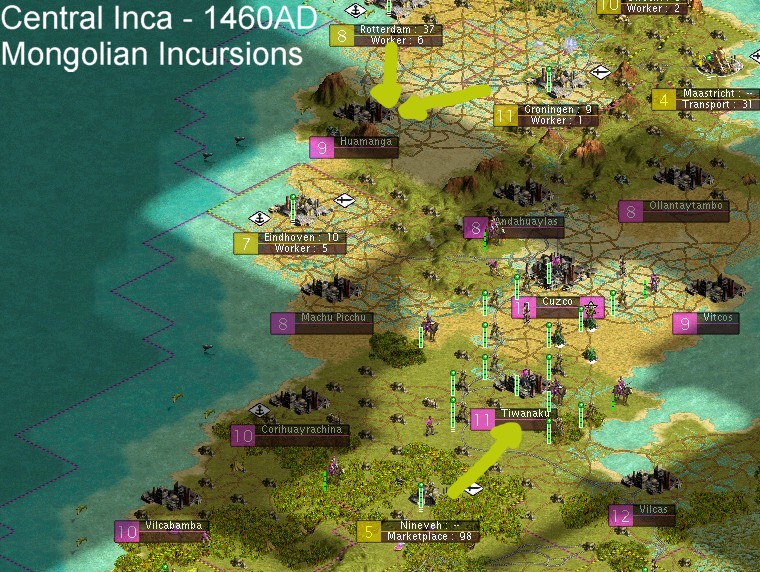
East Inca
Atico was a small hill town nestled East Inca almost as far as east as the Great Dividing Range. Due to the added difficulty in assaulting up a hill, tank divisions were used. Two tank divisions cleared the two rifle divisions to take the town.
Vilcas was the largest Incan city, and also stood on the Mongolian rail network. Vilcas acted as the key transfer point between Central Inca and the important East Incan territory. Here fully two cavalry armies were required to dislodge the defenders.
The large northern coastal city, Arequipa suffered the Mongols onslaught next. The combined effort of the 7th cavalry army and Kublai’s keshik army defeated the three rifle divisions there to seize the city.
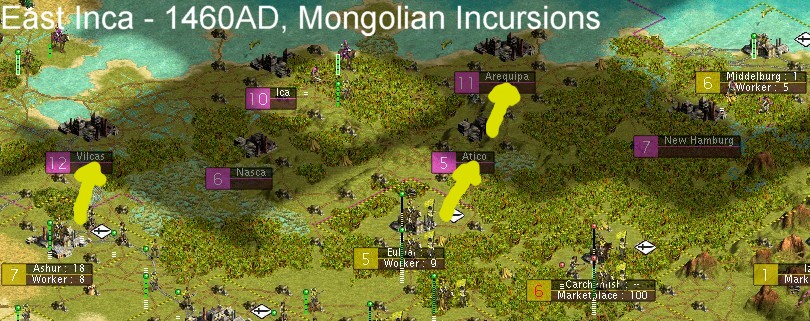
South Inca
The south west was not to go untouched during this opening engagement, either, as Antium was attacked by a tank division, and two musket divisions perished in the failed cause of defending their city.
Shirrupak had only a rifle divisions and a spear division as the defending force and was easily dispatched by a keshik army. Hispalis also fell to determined assaults by the new tank divisions.
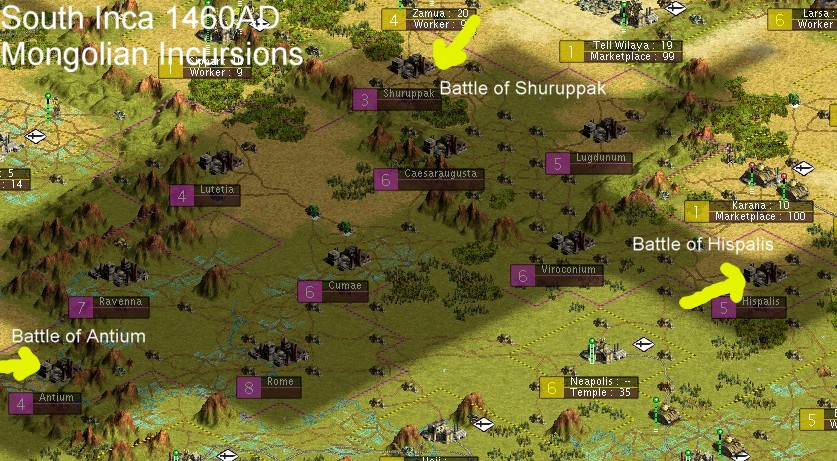
Juli
The town of Juli was hit by two tank divisions, and that was enough to clean out the three rifle divisions, however, one tank divisions was heavily wounded in this hjeated battle and had to limp out to Cincinnatti to recover.
SE Inca
Down south , the former Roamn city of Nicopolis was taken by two tank divisions against musket defenders. The Mongolian force then moved up so that tanks and two cavalry armies could capture Chuito. Tarentum also fell to tank attacks.
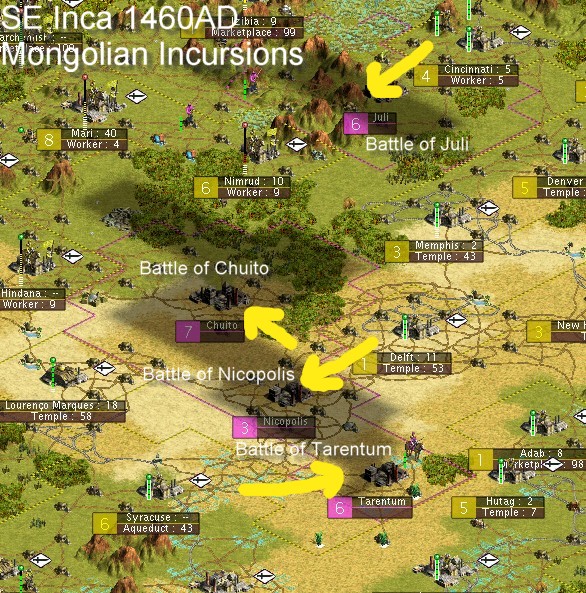
This ended the initial Mongolian attacks, and stirred a vigorous response from the Incans. Cavalry divisions made use of Mongolian rail infrastructure outside of border controls to sweep at numerous targets. Fully six worker crews were seized in the audacious attacks. The Incan assaults on fortified infantry positions were fierce to say the least, with many attackers paying the ultimate price. However, it was only at Veii, where a particularly determined force broke through the infantry defence and claimed a city back off the Mongols.
As the Mongolian public heard the news, commotion started in the streets. The Khan was to take no chances with the fickle people. He had all the technological know-how that he needed for know. The sages were recalled to the palace to have their funding temporarily cut to the bone. The Mongolian people were then flooded with luxuries to distract them from any unfortunate, but inevitable repercussions of the war.
The Khan called an emergency war-cabinet meeting to consider how to contain the Incan counterattacks so as to restrict the damage already done to the peoples’ willingness to pursue this Pax Mongolia philosophy. Subedei had no doubt that the problem laid with the significant numbers of cavalry divisions still at the Incan’s disposal. With their ability to move rapidly, these cavalry represented an ever present and real danger to the Mongolian settlements around the war zones. To limit damage this force must be substantially degraded.
To be continued
Amazing throughout the short but brutal war on the Babylonians, the Incans kept very quiet. The right of passage treaty between the Mongols and the Incans was still in force which was quite incredible given the way that the Mongols had abused the terms of these agreements in the past. The reason for the Incan indifference was to become known to the Mongols when they successfully planted a spy into the Incan heartland in 1460AD.
The Incan military was almost 1.2 million troops! Included in this force was 70 divisions of the powerful rifle divisions and 47 divisions of the still highly effective cavalry divisions. Clearly with any offensive aimed at the Incans, the Incans would be able to bite back, and given the paranoia of the free populace under the democratic government, this could certainly hurt the war effort. Troop numbers were actually closer to 1.4 million, but this included numerous now outdated divisions.
With 30 cities as well, the Incans were significantly larger than the previous foes, and certainly would not crumble nearly as easily to the Mongols offensive. Still the Mongols now had a regular stream of tanks, and infantry, not to mention over twenty of the highly effective army units. Delay would just delay the ultimate declaration of peace through the Pax Mongolia, so once again, troops were positioned for maximum effectiveness utilising the right of passage agreement.
During this time, there were few Incans who were concerned about the movement of Mongolian troops through their lands. After all, this had been going on for a long time now! Those that raised concerns were quickly rebuffed, and reminded of the friendship between the two nations, and the strong army of the Incans. Also, Inca still has no natural railroads of its own. So communications were slow via the road networks in place. This enabled the Mongols to launch their first attacks with almost complete surprise.
The Incan territory was composed of four large territories surrounding the former Babylonia, and with two solitary isolated cities, one in the far east, and one close to South East Inca. This meant a huge logistical problem as far as securing the enormous shared border with the foe, so it was important that the war be over with quickly!

Some in the Khan’s war cabinet advised a rest between the Babylonian campaign and the Incan campaign, pointing to the need for the soldiers to rest, and the fact that more tank divisions were rapidly coming on line, enabling an ever more overwhelming attack to occur. The Khan would have none of this. With the potential for true lasting peace so close to his grasp, the troops were ordered into their respective positions without delay. The action was to commence in Central Inca – the heartland of the enemy itself!
Central Inca
Tiwanaku received the first shots of the campaign. Tiwanaku was the key to the northern cities with the Mongolian rail infrastructure already built around the city during the Dutch War. Artllery struck the city first, fired from afar. Even the mighty Incans had no answer to this onslaught, leaving the three rifle divisions easy prey to the third keshik army.
Huamanga was the Incan city farthest to the North, and annoyingly added substantially to the northern front with the enemy. This was due to how the Dutch had colonised just to the city’s south. That city, Eindhoven, now of course belonging to the Mongols. Therefore it was crucial that it fell quickly so as to secure the north-west peninsular. It only took the first cavalry army to crush the three rifle divisions defending there, and remove this threat.

East Inca
Atico was a small hill town nestled East Inca almost as far as east as the Great Dividing Range. Due to the added difficulty in assaulting up a hill, tank divisions were used. Two tank divisions cleared the two rifle divisions to take the town.
Vilcas was the largest Incan city, and also stood on the Mongolian rail network. Vilcas acted as the key transfer point between Central Inca and the important East Incan territory. Here fully two cavalry armies were required to dislodge the defenders.
The large northern coastal city, Arequipa suffered the Mongols onslaught next. The combined effort of the 7th cavalry army and Kublai’s keshik army defeated the three rifle divisions there to seize the city.

South Inca
The south west was not to go untouched during this opening engagement, either, as Antium was attacked by a tank division, and two musket divisions perished in the failed cause of defending their city.
Shirrupak had only a rifle divisions and a spear division as the defending force and was easily dispatched by a keshik army. Hispalis also fell to determined assaults by the new tank divisions.

Juli
The town of Juli was hit by two tank divisions, and that was enough to clean out the three rifle divisions, however, one tank divisions was heavily wounded in this hjeated battle and had to limp out to Cincinnatti to recover.
SE Inca
Down south , the former Roamn city of Nicopolis was taken by two tank divisions against musket defenders. The Mongolian force then moved up so that tanks and two cavalry armies could capture Chuito. Tarentum also fell to tank attacks.

This ended the initial Mongolian attacks, and stirred a vigorous response from the Incans. Cavalry divisions made use of Mongolian rail infrastructure outside of border controls to sweep at numerous targets. Fully six worker crews were seized in the audacious attacks. The Incan assaults on fortified infantry positions were fierce to say the least, with many attackers paying the ultimate price. However, it was only at Veii, where a particularly determined force broke through the infantry defence and claimed a city back off the Mongols.
As the Mongolian public heard the news, commotion started in the streets. The Khan was to take no chances with the fickle people. He had all the technological know-how that he needed for know. The sages were recalled to the palace to have their funding temporarily cut to the bone. The Mongolian people were then flooded with luxuries to distract them from any unfortunate, but inevitable repercussions of the war.
The Khan called an emergency war-cabinet meeting to consider how to contain the Incan counterattacks so as to restrict the damage already done to the peoples’ willingness to pursue this Pax Mongolia philosophy. Subedei had no doubt that the problem laid with the significant numbers of cavalry divisions still at the Incan’s disposal. With their ability to move rapidly, these cavalry represented an ever present and real danger to the Mongolian settlements around the war zones. To limit damage this force must be substantially degraded.
To be continued
Sandman2003
Prince
Chapter Twenty Two continued
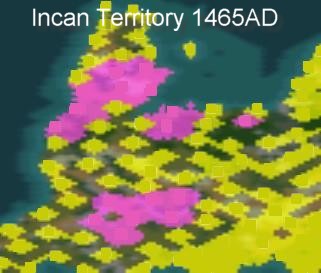
Bengal
With nineteen cities still in the hands of the Inca, the city count must continue to fall as well. So in 1465AD, the attacks started anew. The small town far out to the east, Bengal, was hit first. With the assistance of cannons, the musket divisions held fast, and withstood one tank division assault, in the process destroying the attackers. However, this close to the Mongolian core, replacement divisions were readily available, and two new divisions swept in, succeeding where their fallen comrades had failed.
SE Inca
With more worker crews rushed in to complete rail links, Viroconium is hit next. In all four tank divisions and two cavalry divisions are employed, with one tank division retreated from the battle, and one cavalry division destroyed, but the three rifle and one cavalry division of the defenders is also destroyed.
By Ashur, Juli and Karana, Incan cavalry divisions are ambushed and destroyed. In the process another Mongolian general steps forward. Another empty army is created.
East Inca
Then the assault on Nasca begins. It is believed that this city houses most of the captured workers. As the tenth cavalry army dispenses with the rifle, musket and cavalry divisions defending, this theory is soon proven correct, and numerous Mongolian workers are liberated, a huge bonus given the high demand for strategic rail links right at the moment.
At New Hamburg, the seventh keshik army had settled in by the city gates. With the troops fully rested the assault on the city commenced. Three rifle divisions later, the army was triumphantly marching down the main street of this once German, former Incan and now Mongolian city.
South Inca
In the south, the city of Lugdunum is assaulted by Chagatai’s keshik army which succeeds against the odds and liberates the former Roman city from its three Incan rifle division garrison.
At Ceasaraugusta, the Incans attempted to consolidate their defensive efforts. This process met with partial success as although the city ultimately fell, it took a Mongolian cavalry division with it, and routed the assault of the seemingly invincible tanks. Of course, Incan casualties continued to be higher with three rifle divisions and two cavalry divisions perishing in the battle.
The city of Veiii was not long left in the hands of the Incans either. A tank division and a cavalry division dispensed with the two cavalry divisions present to reclaim the city.
At the former Roman capital of Rome, another leader emerges from a successful tank battle as the third cavalry army, two tank divisions, a keshik and a cavalry division destroy three rifles and two cavalry divisions to take the city.
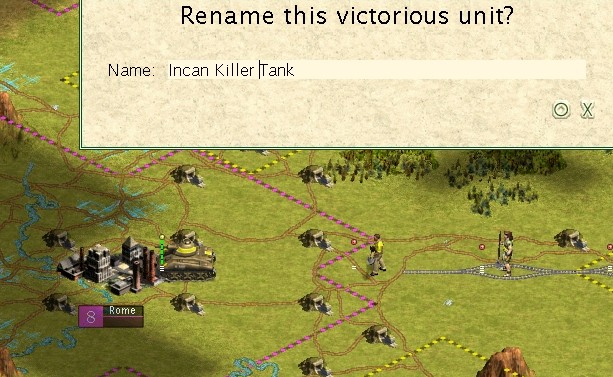
More Incan troops are caught in the open by Ceasaraugusta. A further tank division is deployed to destroy a cavalry division and a keshik army dispenses with two cavalry divisions and a knight division.
Finally, at Cumae, two tank divisions each destroy a musket division and the fifth cavalry army destroys a knight and a cavalry division to claim the city.
Central Inca
At Vilcabamba, the eleventh cavalry army faces no less than four rifle divisions, before single-handedly claiming the city. Further action in the central region sees a mixed force of Mongolian cavalry, infantry and artillery used in destroying a further three divisions of Incan cavalry from around Ninevah and Tiwanaku.
Subedei finally launches his audacious attack in the very seat on Incan power, the capital city of Cuzco. As expected, the resistance from this city is ferocious, and it takes fully five of the very powerful Mongolian army units to smash through the defensive forces and seize this Incan Prize.
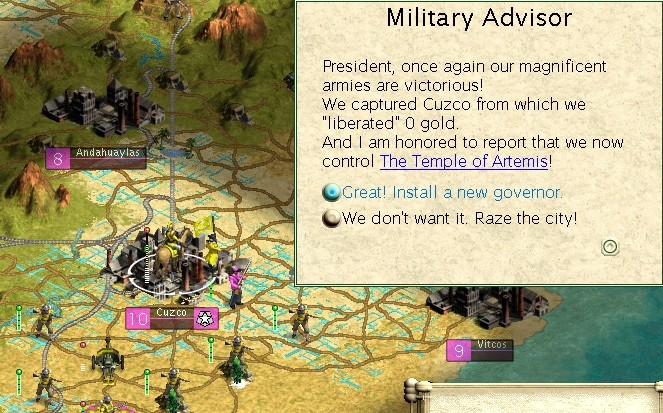
With the abundance of superior living conditions becoming available within the Mongolian empire, the citizens of the icy north, particularly in former American territory demand better living conditions. As a result of this demand, there is a migration from these locations into warmer climates, leaving two of these previously American cities completely abandoned.
The massive attacks launched against the Incan cavalry divisions were enough to reduce their numbers down to just eight divisions, but they still have enough punch left to cause one more headache for the Mongols. The city of Shurrupak was captured by the Incans.
As 1470AD dawned, the mighty Incans had been reduced to just nine cities, and only had six divisions of offensive cavalry. Subedei was determined that this would be their final year as an independent state.
After destroying a cavalry division by Tiwanaku, Subedei’s forces attacked Corithuayrachina first with artillery until all the rifle divisions were at their most degraded. This was followed up by the ninth cavalry army killing two rifles divisions and the second cavalry army finishing off the third rifle division and a long bow division to claim the city.
A tank division cleared another cavalry division near Ninevah.
Macchu Picchu was brought into range next. The seventh keshik army backed by the fourth cavalry army destroyed the three rifle divisions garrisoning the city to calim it.
Then, like the hands of a clock, the offensive moved on to Andahuaylas. Between a cavalry army and the second keshik army, the three rifle divisions garrisoning here were wiped out, giving another city to the Mongols.
Ollantaytambo was attacked next. This time there was the advantage of being able to employ an artillery barrage degrading the units to the maximum. A highly wounded sixth cavalry army was then forced to enter the fray, instead of recuperating, and earnt top honours by destroying three rifle divisions to single-handedly claim the city.
The Vitcos was also weakened by artillery. Vitcos was within range of tank assault, and so fresh tank divisions were employed. However, the new tank commanders were very green, and the first division fell. Following this the Mongolian forces perfomed better with four rifle divisions destroyed with one tank division retreated. But it took the effort of two more damaged cavalry armies, Tolui’s and the tenth cavalry army, to finish off the last two rifle divisions and claim the city.
Ica, the last city in the north (east Inca) fell to a tank division and the 7th cavalry army.
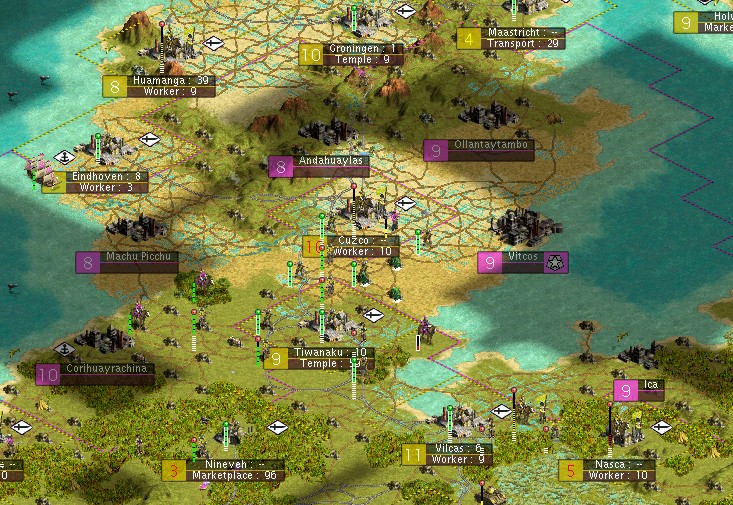
In the south, the Incans had three cities left, including the recently captured Shurrupak. A single tank division was quickly dispatched to rescue Shurrupak, leaving but two Incan holdings. Then at Ravenna, the Incans were down to musket defenders. Utilising a tank division, three cavalry divisions and a keshik army the city finally fell, but it didn’t go without a fight. The Mongols suffered the loss of a cavalry division and an embarrassing retreat of a cavalry division against the relatively weaker defence. Incan losses were three musket divisions and a longbow division.
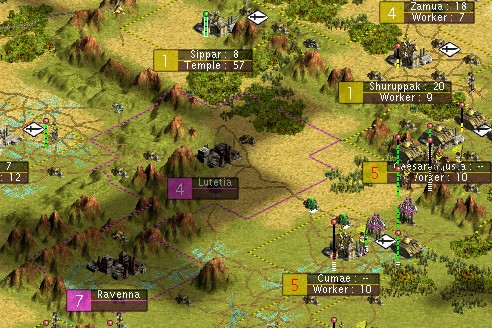
At the final Incan stronghold of Lutetia, two healthy tank divisions killed a rifle division and a musket division respectively to leave a single longbow division garrisoning the city. A highl;y damaged tank division was brought into the fray to finish the job.
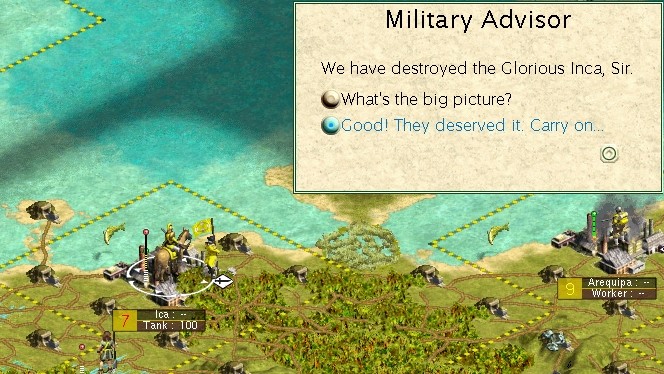
This left only the minor irritation of the east, the Byzantines left to deal with. The resettlement of tundra based citizens to warmer climes continued. This time, no less than five former tundra towns were completely abandoned, though this time they were mainly from former Scandinavia. The priority of builds is now completely changed. There is no need for tanks, so everywhere these builds are changed to marines. In addition a transport was rushed as close to the target city of the Byzantines as possible. The Byzantines were able to perform one last indignity against the Mongols. An attempt to discover the extent of the Byzantine defence was defeated with the Mongolian spy caught and killed. Of course this made no impact on the inevitability of the conflict against the Byzantines.
In 1475AD, four more tundra towns were abandoned in the resettlement project.
In 1480AD six marines sailed to the Byzantine city of Septum. The smug Byzantines were shocked to be attacked from the sea by a Mongolian force, and one of considerable power as well. The first two marine divisions account for a Byzantine rifle division and a Byzantine pike division, and then there is no more.
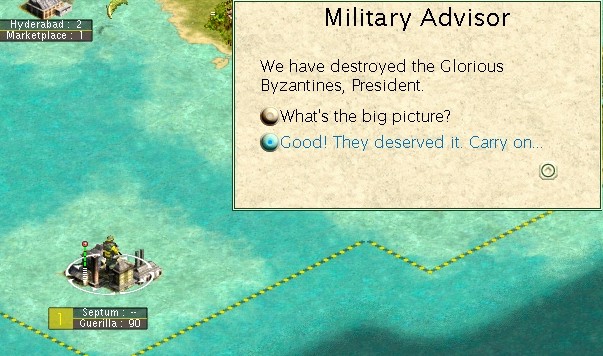
The Pax Mongolia is complete. Without external threats to continue to drive the great Mongols onward will the future hold further greatness, or will the mighty Mongols sink under their own success? The question remains one for future generations to fathom, certainly the Great Khan achieved his magnificient dream of uniting the world under the single dominant culture of the Mongols, and shortly thereafter retired, leaving the fate of the world in others hands.
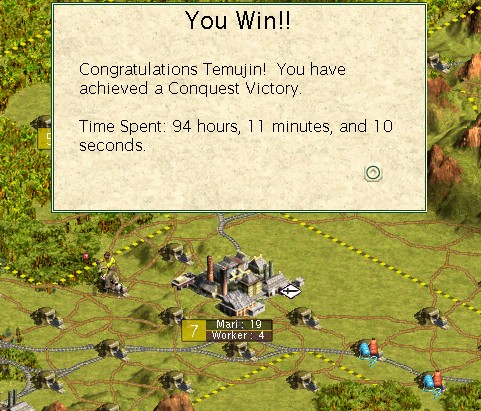

Bengal
With nineteen cities still in the hands of the Inca, the city count must continue to fall as well. So in 1465AD, the attacks started anew. The small town far out to the east, Bengal, was hit first. With the assistance of cannons, the musket divisions held fast, and withstood one tank division assault, in the process destroying the attackers. However, this close to the Mongolian core, replacement divisions were readily available, and two new divisions swept in, succeeding where their fallen comrades had failed.
SE Inca
With more worker crews rushed in to complete rail links, Viroconium is hit next. In all four tank divisions and two cavalry divisions are employed, with one tank division retreated from the battle, and one cavalry division destroyed, but the three rifle and one cavalry division of the defenders is also destroyed.
By Ashur, Juli and Karana, Incan cavalry divisions are ambushed and destroyed. In the process another Mongolian general steps forward. Another empty army is created.
East Inca
Then the assault on Nasca begins. It is believed that this city houses most of the captured workers. As the tenth cavalry army dispenses with the rifle, musket and cavalry divisions defending, this theory is soon proven correct, and numerous Mongolian workers are liberated, a huge bonus given the high demand for strategic rail links right at the moment.
At New Hamburg, the seventh keshik army had settled in by the city gates. With the troops fully rested the assault on the city commenced. Three rifle divisions later, the army was triumphantly marching down the main street of this once German, former Incan and now Mongolian city.
South Inca
In the south, the city of Lugdunum is assaulted by Chagatai’s keshik army which succeeds against the odds and liberates the former Roman city from its three Incan rifle division garrison.
At Ceasaraugusta, the Incans attempted to consolidate their defensive efforts. This process met with partial success as although the city ultimately fell, it took a Mongolian cavalry division with it, and routed the assault of the seemingly invincible tanks. Of course, Incan casualties continued to be higher with three rifle divisions and two cavalry divisions perishing in the battle.
The city of Veiii was not long left in the hands of the Incans either. A tank division and a cavalry division dispensed with the two cavalry divisions present to reclaim the city.
At the former Roman capital of Rome, another leader emerges from a successful tank battle as the third cavalry army, two tank divisions, a keshik and a cavalry division destroy three rifles and two cavalry divisions to take the city.

More Incan troops are caught in the open by Ceasaraugusta. A further tank division is deployed to destroy a cavalry division and a keshik army dispenses with two cavalry divisions and a knight division.
Finally, at Cumae, two tank divisions each destroy a musket division and the fifth cavalry army destroys a knight and a cavalry division to claim the city.
Central Inca
At Vilcabamba, the eleventh cavalry army faces no less than four rifle divisions, before single-handedly claiming the city. Further action in the central region sees a mixed force of Mongolian cavalry, infantry and artillery used in destroying a further three divisions of Incan cavalry from around Ninevah and Tiwanaku.
Subedei finally launches his audacious attack in the very seat on Incan power, the capital city of Cuzco. As expected, the resistance from this city is ferocious, and it takes fully five of the very powerful Mongolian army units to smash through the defensive forces and seize this Incan Prize.

With the abundance of superior living conditions becoming available within the Mongolian empire, the citizens of the icy north, particularly in former American territory demand better living conditions. As a result of this demand, there is a migration from these locations into warmer climates, leaving two of these previously American cities completely abandoned.
The massive attacks launched against the Incan cavalry divisions were enough to reduce their numbers down to just eight divisions, but they still have enough punch left to cause one more headache for the Mongols. The city of Shurrupak was captured by the Incans.
As 1470AD dawned, the mighty Incans had been reduced to just nine cities, and only had six divisions of offensive cavalry. Subedei was determined that this would be their final year as an independent state.
After destroying a cavalry division by Tiwanaku, Subedei’s forces attacked Corithuayrachina first with artillery until all the rifle divisions were at their most degraded. This was followed up by the ninth cavalry army killing two rifles divisions and the second cavalry army finishing off the third rifle division and a long bow division to claim the city.
A tank division cleared another cavalry division near Ninevah.
Macchu Picchu was brought into range next. The seventh keshik army backed by the fourth cavalry army destroyed the three rifle divisions garrisoning the city to calim it.
Then, like the hands of a clock, the offensive moved on to Andahuaylas. Between a cavalry army and the second keshik army, the three rifle divisions garrisoning here were wiped out, giving another city to the Mongols.
Ollantaytambo was attacked next. This time there was the advantage of being able to employ an artillery barrage degrading the units to the maximum. A highly wounded sixth cavalry army was then forced to enter the fray, instead of recuperating, and earnt top honours by destroying three rifle divisions to single-handedly claim the city.
The Vitcos was also weakened by artillery. Vitcos was within range of tank assault, and so fresh tank divisions were employed. However, the new tank commanders were very green, and the first division fell. Following this the Mongolian forces perfomed better with four rifle divisions destroyed with one tank division retreated. But it took the effort of two more damaged cavalry armies, Tolui’s and the tenth cavalry army, to finish off the last two rifle divisions and claim the city.
Ica, the last city in the north (east Inca) fell to a tank division and the 7th cavalry army.

In the south, the Incans had three cities left, including the recently captured Shurrupak. A single tank division was quickly dispatched to rescue Shurrupak, leaving but two Incan holdings. Then at Ravenna, the Incans were down to musket defenders. Utilising a tank division, three cavalry divisions and a keshik army the city finally fell, but it didn’t go without a fight. The Mongols suffered the loss of a cavalry division and an embarrassing retreat of a cavalry division against the relatively weaker defence. Incan losses were three musket divisions and a longbow division.

At the final Incan stronghold of Lutetia, two healthy tank divisions killed a rifle division and a musket division respectively to leave a single longbow division garrisoning the city. A highl;y damaged tank division was brought into the fray to finish the job.

This left only the minor irritation of the east, the Byzantines left to deal with. The resettlement of tundra based citizens to warmer climes continued. This time, no less than five former tundra towns were completely abandoned, though this time they were mainly from former Scandinavia. The priority of builds is now completely changed. There is no need for tanks, so everywhere these builds are changed to marines. In addition a transport was rushed as close to the target city of the Byzantines as possible. The Byzantines were able to perform one last indignity against the Mongols. An attempt to discover the extent of the Byzantine defence was defeated with the Mongolian spy caught and killed. Of course this made no impact on the inevitability of the conflict against the Byzantines.
In 1475AD, four more tundra towns were abandoned in the resettlement project.
In 1480AD six marines sailed to the Byzantine city of Septum. The smug Byzantines were shocked to be attacked from the sea by a Mongolian force, and one of considerable power as well. The first two marine divisions account for a Byzantine rifle division and a Byzantine pike division, and then there is no more.

The Pax Mongolia is complete. Without external threats to continue to drive the great Mongols onward will the future hold further greatness, or will the mighty Mongols sink under their own success? The question remains one for future generations to fathom, certainly the Great Khan achieved his magnificient dream of uniting the world under the single dominant culture of the Mongols, and shortly thereafter retired, leaving the fate of the world in others hands.

Vanadorn
Motorcycling Paladin
@ Sandman - Nice read. Nice finish. Congratulations on a great game, story, and read.
V
V
General Mayhem
Monarch
- Joined
- Aug 30, 2004
- Messages
- 329
Great finish, this was a great story to follow, hope you start another one at some point.
Tman65
Warlord
Well played and well written!!! Encore!
Sandman2003
Prince
kylaar - I found that writing stories forces you to concentrate on your game more, and so it helped me improve mine. Good luck, and hope you give it a whirl.
Thanks Vanadorn, General Mayhem and Tman65, the comments are always appreciated.
rbis4rbb - I lost the screen dumps of the various stats, but I can tell you this - end score was about 9500 firaxis points, area was 66%, pop 100%, culture about 20k.
Thanks Vanadorn, General Mayhem and Tman65, the comments are always appreciated.
rbis4rbb - I lost the screen dumps of the various stats, but I can tell you this - end score was about 9500 firaxis points, area was 66%, pop 100%, culture about 20k.
Sir Donald III
Emperor
- Joined
- Aug 9, 2004
- Messages
- 1,074
66% Area! You just edged Conquest over Domination! And no Razings? Or was the Abandonment of the Tundra how you kept under the Dominion limit?
Sandman2003
Prince
I used Dianthus' superb utility CrpSuite (Mapstat) which gives tiles to domination limit, and the cultural expansions due next turn. From that you can estimate what you need to abandon. And yes the abandonment of tundra towns was the essential elimination of cities to stay under the dom limit.Sir Donald III said:66% Area! You just edged Conquest over Domination! And no Razings? Or was the Abandonment of the Tundra how you kept under the Dominion limit?
mevlin
Chieftain
Good stuff Sandman. Looking forward to the next one!!
dnassman
Chieftain
Great story and pics.
Lord Parkin
aka emperor
Once again, a brilliant read Sandman. 

Sorry if this thread is too old for a new post, but I just have to post some comments/questions.
Like others have said, this is a great read! The keep-under-domination-limit trick was pretty cool. If you hadn't done it, when would you have won by domination? Also, why isn't it said in the game parameters that Culture flip is turned off (and I know it is, because you didn't lose a single city to it and this is Emperor)?
Like others have said, this is a great read! The keep-under-domination-limit trick was pretty cool. If you hadn't done it, when would you have won by domination? Also, why isn't it said in the game parameters that Culture flip is turned off (and I know it is, because you didn't lose a single city to it and this is Emperor)?
carmen510
Deity
Hi choxorn. Please don't bump old threads. BTW, nice story!  Please don't spam in this choxorn. Please......
Please don't spam in this choxorn. Please......
 Please don't spam in this choxorn. Please......
Please don't spam in this choxorn. Please......tupaclives
Tupac Lives on!!
Ack, though I thoroughly detest spamming in old threads, this comment got to me.
That he didn't lose a city and its emperor means nothing. I play SP deity games (on vanilla where its impossible to turn off culture flipping) and don't lose any cities to flips. It may be that he did turn it off, i don't know, but don't presume that he isn't being completely honest just because this game doesn't match experiences you may have had.
choxorn said:Also, why isn't it said in the game parameters that Culture flip is turned off (and I know it is, because you didn't lose a single city to it and this is Emperor)?
That he didn't lose a city and its emperor means nothing. I play SP deity games (on vanilla where its impossible to turn off culture flipping) and don't lose any cities to flips. It may be that he did turn it off, i don't know, but don't presume that he isn't being completely honest just because this game doesn't match experiences you may have had.
Similar threads
- Sticky
- Replies
- 30
- Views
- 2K
- Replies
- 10
- Views
- 753
- Replies
- 10
- Views
- 2K
- Replies
- 0
- Views
- 218
- Replies
- 17
- Views
- 2K
